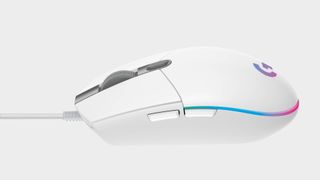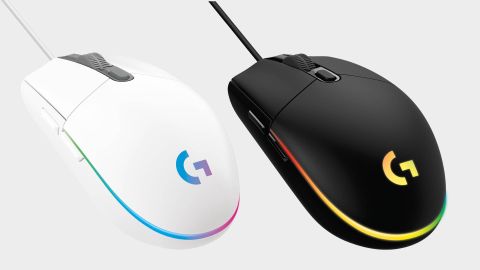Our Verdict
The Logitech G203 Lightsync is much like the G203 Prodigy: dependable, responsive, and light. The fact that the degree to which you can configure the onboard LEDs is the only distinguishing mark between the two means whichever you find cheapest comes out on top.
For
- Affordable
- Three-zone RGB lighting
- Lightweight
Against
- G203 Prodigy is cheaper for now
- Tough competition at this price
PC Gamer's got your back
If you find the Logitech G203 Lightsync familiar, you're not the only one. The latest gaming mouse from Logitech G may be tipped as a new arrival, but it is almost functionally identical to the G203 Prodigy that preceded it. Regardless, it's a popular and a cheap enough gaming mouse, so maybe it's due a re-review.
The G203 Lightsync is a wired mouse—it's Lightspeed that you're looking for if you're after a wireless rodent. Instead, Lightsync denotes this mouse's complete compatibility with the Logitech G app and RGB lighting system, which is able to unify RGB lighting effects across compatible Logitech products. What's somewhat confusing is that non-Lightsync products are also able to integrate with said app to varying degrees.
Therein lies one of the changes introduced with the G203 Lightsync: the degree to which you can fiddle with its RGB lights in-app. That's one of just two minor changes in total between it and the G203 Prodigy. Where the Prodigy has a mere one Lightsync zone configurable within the Logitech G app, the Lightsync has three.
It's far from a significant overhaul, but I'll admit there's not much in need of changing within the G203's otherwise simple construction. The three titular lighting zones all lie within the thin strip that spans the rear palm rest, with the logo above taking the same colour as the middle RGB lighting zone. While it might've been nice to have independent control of the logo itself, the option does allow for gorgeous tri-colour gradient effects sweeping from one side of the mouse to the other.
The G203 Lightsync's three-zone lighting also allows for two newly-available RGB lighting effects: colour wave and colour blend.
Pair these with the G203 Lightsync's slightly tweaked white and grey option (as opposed to the white and black option previously available with the Prodigy) and you're onto something quite stunning for $40. That's right, the only other difference to note with the G203 Lightsync over its predecessor is the introduction of a grey scroll wheel reservation, as opposed to the bog-standard black adopted previously.

I've gone for the white colourway for the test unit for this review, and while I can't tell you what it will look like in five years time, I can tell you that it looks quite stunning out of the box.
That's about all to report in terms of changes between the two G203 models—told you they were nearly identical, didn't I? The G203 Prodigy is now end-of-life, however, and it appears all parts once destined for the Prodigy have been earmarked for the Lightsync from here onward.
Expect the same near-ambidextrous design with the G203 Lightsync then, complete with two buttons under whereabouts the pad of your right-hand thumb would sit. These aren't removable or swappable to the opposite side, which certainly comes as a surprising flaw in the Logitech G203's otherwise one-size-fits-all design. Nevertheless, it's a simple design, and one which Logitech aptly calls "tried and true".


The unnamed "gaming-grade" sensor within the G203 offers a DPI range of 200-8,000, which should prove more than enough for all but the most colossal of 4K monitors—at which point you might want to turn to something with a little more grandeur than the G203. The sensor is more than suitable for decent and consistent gaming, and turns up a clean sheet in mouse sensor tests.
At $40 (£35), the G203 Lightsync sits within a hotly-contended category of budget-conscious gaming mice. Most of all it faces stern competition from Razer, whose lineup at this price, or thereabouts, now includes the Deathadder Essential, Basilisk Essential, and Viper Mini. However, the G203 Lightsync has enough about it to stand its own. Its no-nonsense design packs the bare essentials, and it builds upon that slight flair for the aesthetic that you won't find quite so pronounced anywhere else.
Perhaps Logitech's unwillingness to reinvent the budget-conscious gaming mouse with every iteration of the G203 begets a quiet confidence in what it's bringing to the more affordable segment of its sprawling mouse lineup. The changes introduced with the G203 Lightsync, however few, may make for a materially slim review, but we're also not jumping at the chance to shift it out from our best gaming mouse roundup just yet.
That being said, if you do happen to stumble across a cheap G203 Prodigy in this post-Lightsync world, you should jump at the chance while you still can. It won't be floating around the $30 mark for long. Almost all of the above applies to the older version too, and that all makes for a great budget gaming mouse—if only one just a little less flashy.
The Logitech G203 Lightsync is much like the G203 Prodigy: dependable, responsive, and light. The fact that the degree to which you can configure the onboard LEDs is the only distinguishing mark between the two means whichever you find cheapest comes out on top.

Jacob earned his first byline writing for his own tech blog. From there, he graduated to professionally breaking things as hardware writer at PCGamesN, and would go on to run the team as hardware editor. He joined PC Gamer's top staff as senior hardware editor before becoming managing editor of the hardware team, and you'll now find him reporting on the latest developments in the technology and gaming industries and testing the newest PC components.
